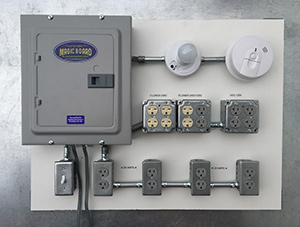



Checking Your Electricity
Do you have enough electricity for your new grow room? No matter what the size of the space is that you plan on using, making sure that you have enough electricity and that it is setup correctly is very important. Sloppy wiring jobs and running circuit breakers near their maximum capacity leads to fires and people getting hurt or worse. Some homes that were built 50 years ago have a tendency to have multiple kinds of wiring running throughout the house, and not only that but some circuit breakers may be serving different parts of the house that you wouldn’t expect.
If you are starting out with a small space then you may or may not have any issues just plugging into the electrical outlet. To be safe you will want to add up all of the amp settings on everything electrical that you will be using. If you are using a ballast to drive your lighting, you will want to add in an additional 25% of its amp rating because when a ballast starts up it temporarily goes beyond its running amperage setting before evening out. So say you have a ballast that is rated for 9.5 amps, add another 2.5 amps (rounding up from 2.375 to be safe) and you are at 12 amps for your ballast & light. Then if you run an inline centrifugal fan to cool your light add in that amp setting, lets use 1.2 amps. We are now at a total of 13.2 amps. If your circuit breaker that you will be using is only rated for 15 amps, that is all you will want to run from that outlet and not use any of the other outlets that run to that same circuit breaker. Any additional equipment that you will be using like a carbon filter with another centrifugal fan, a wall fan to keep the air moving in the space, or hydroponics equipment will need to be plugged into an outlet that runs to a different circuit breaker.
Circuit breakers by design will trip and disconnect power from all of the outlets and switches that it serves if it becomes overloaded. However, sometimes the circuit breaker will trip and disconnect the power but the actual switch will not be thrown to the off position. Sometimes things don’t always go as planned in older homes and it never hurts to be extra safe. To make sure that you are not putting an excessive load on a breaker, the first thing to do is to identify one of the outlets that you will be using in your space and trace it back to the electrical panel, this can be done simply by plugging something into the outlet and then turning off breakers until your device goes off. If you have an outlet tester ($5 ebay) even better because that will show you if the outlet is grounded properly, and if it is not, you will want to address that first.
Next you will need to remove the electrical panel cover where all of your circuit breakers are located to expose the wiring, be very careful as all of these wires are live. Now you can use a multimeter with a clamp on it ($12 ebay) and loop it around the hot wire (usually the black wire) and if you have the meter dialed to the correct setting to measure AC amperage it will tell you how many amps are being drawn by that breaker at that exact moment.
If using a multimeter and messing with your home’s electrical panel is a bit much for you, I would suggest replacing the outlets with what are called GFI outlets. The GFI or Ground Fault Interrupt outlet contains a breaker switch that will trip and shut off power at the outlet in the event that it becomes overloaded ($18 at hardware stores). Make sure that you turn off the circuit breaker that serves the outlet prior to changing it out.
When planning the size of the grow room you should also be mindful about the amount of electricity that you will be using. If all of your neighbors electrical bills are $75 and yours is $500, this might draw attention to the property from the electrical company. You will want to be off the radar of anyone and everyone so I would suggest that you size your space with this in mind, don’t be paranoid just be smart.
Dedicated Electrical Panels
In larger grow rooms you will want to segment your electricity entirely from the house, including the installation of a dedicated electrical panel. Hopefully you know an electrician that can do this work for you, if you are not well versed in electrical wiring attempt at your own peril. If you click on the image to the right you can see that this setup has everything segmented nicely using different outlets for flowering and vegetative equipment as well as providing the ability to utilize both 120 and 240 volt systems. And then the 4 outlets along the bottom are all being driven by their own separate 20 amp circuit breakers.
Now we can move on to one of the most important factors in the grow room, The Lighting ![]()

